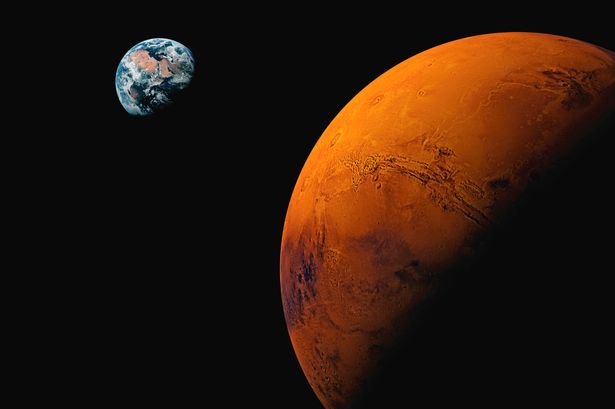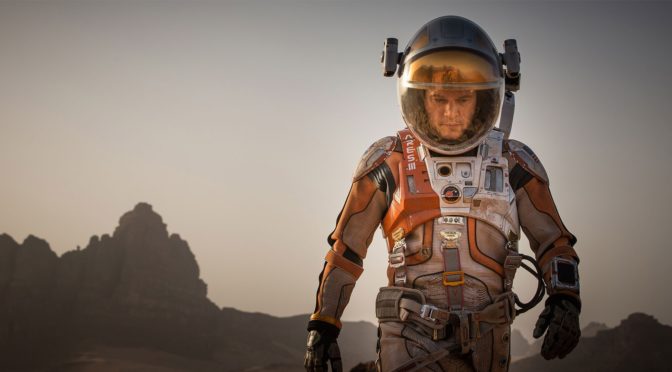Mars is a dying planet
What is living, what is dead? A definition that I find useful for “life” in a non-biological sense is that which tends toward order; non-living things tend toward disorder. Another way of putting it is that changes in non-living things occur only by outside influences. Living things can change and form orderly structures.
In Biology, a living organism grows and forms an ordered structure. When it dies, it decays; other organisms or inorganic processes take it apart. Now, take that definition to non-biological things or systems.
The Moon
The Moon is a dead planetoid. The only changes that occur result from outside influences. The most obvious are meteor impacts. In addition, there is some minor breakdown by the intense heat and cold cycles on a monthly basis. Large meteor impacts may heat up the surrounding rock enough to melt it. That is the source of the lunar maria (so-named because early astronomers thought they were seas). The majority of the lunar surface is primarily made up of anorthosite. The many samples of anorthosite brought back from the Apollo lunar missions crystalized about 4 billion years ago. The Moon has been dead for 4 billion years.
Earth
Earth’s heat sources
The Earth is a living planet – not just because it harbors biological life. The Earth has an internal heat source – the inner and outer core and the mantle have latent heat, leftover from the formation of the planet. Much of that heat was produced by the energy of meteoric impacts and from gravitational compression as the planet grew. There is also heating from radioactive elements, thought to be primarily in crustal rocks, though it is likely that some radioactive elements also exist in the core. In addition, some amount of heating is generated from Earth tides – the change of Earth’s shape due to gravitational interaction with the Sun and Moon. Eventual heat loss and solidification of the core, through convection, conduction, and radiation, is estimated to take tens of billions of years. That is, unless the Earth is totally destroyed when the Sun burns out in an estimated 5 billion years. So, why is this internal heat source important?
The heat within the Earth, along with gravity, is what drives convection in the mantle of the Earth. The rocks of the mantle undergo differentiation with the lighter minerals rising to the top and forming the crust. The lithosphere (crust and uppermost mantle) is broken up into plates that move about atop the mantle. Their interaction with each other, with the mantle below, and the ocean above (plate tectonics) is what keeps mountain building going. If the mantle became totally solid, plate tectonics would cease, and eventually the continents would erode down to sea level. That would make life difficult for land plants and animals. But that alone would not make Earth a dead planet.
Earth’s Magnetic Field
The molten outer core is believed to be responsible for Earth’s magnetic field. The magnetic field protects the Earth from the effects of the solar wind. If the outer core became solid the magnetic field would be no more, and the solar wind would eventually strip away the Earth’s atmosphere. That would be catastrophic for biologic life on Earth, as the oceans would also evaporate.
What happens when the magnetic field decreases during a reversal (swapping of north and magnetic poles, as happens occasionally – on the order of thousands to tens of millions of years)? Fortunately, it is estimated that it would take several billion years to remove most of the atmosphere. There is the question of genetic damage from increased cosmic radiation during a reversal. Maybe that has caused an increase in the rate of evolution, but life has survived many such reversals.
Mars
The loss of its magnetic field is exactly the predicament in which we find Mars. The magnetism that has been measured is a weak remanent magnetism of crustal rocks. That remanent magnetism was acquired from a past global magnetic field by certain metallic minerals when they were hot, and remained as they cooled.
There is evidence that Mars at one time had oceans, and therefore a much thicker atmosphere. Mars is only about 1/8 the volume of Earth and 1/10 the mass. Its small core would have cooled much more rapidly than Earth’s. Recent measurements of Mars tides1 suggest its core is not completely solid, but it no longer has the internal circulation needed to generate a magnetic field. Because of this, Mars now has little or no global magnetic field, and that has apparently been the case for about 4 billion years.
So, Mars has lost most of its atmosphere, and with the low atmospheric pressure, surface water has evaporated and been lost as well. There is still evidence of moisture seasonally at the polar regions, and there may still be some groundwater. Mars is not dead, but it is dying. When it dies, there is little prospect for sustaining life, certainly not Earthly life.
Can we terraform Mars?
Some have posited the idea that we can terraform and colonize Mars. Mars’ atmosphere is about 95 percent carbon dioxide, with very little oxygen or nitrogen. The Mars Rover Perseverance successfully made breathable oxygen from carbon dioxide. That would allow astronauts to manufacture oxygen for whatever habitats they build to live in on Mars. If there is subsurface water or ice, that could perhaps be filtered to provide for the needs for those limited habitats.
But that doesn’t make Mars habitable on any large scale. To make Mars truly habitable, we would need to create an atmosphere that is comparable to that on Earth. That means keep the existing carbon dioxide, which is at an abundance close to that on Earth (considering that Mars’ total atmosphere is about as much as the Earth’s atmospheric carbon dioxide), and add enough nitrogen and oxygen to get the atmospheric pressure to at least that on high mountains on Earth (~10,000 feet elevation). You cannot manufacture that from Mars’ current atmosphere. If there is a way to create these gases from something in Mars’ crustal rocks (oxygen is abundant in the rocks), it would take thousands (more likely, millions) of years. Meanwhile, the solar wind would be removing them as fast as you make them. In other words, it can’t be done.
Ray Bradbury had it right in 1950 2 – Mars is a dying planet. And there is nothing we can do to change that.
Featured image: Mars Earth composite image from Getty images
References
1. Callaghan JO. InSight Lander Makes Best-Yet Maps of Martian Depths. Scientific American. 2021 July 22 [accessed 2022 June 14]. https://www.scientificamerican.com/article/insight-lander-makes-best-yet-maps-of-martian-depths/
2. Bradbury R. The Martian Chronicles. Simon & Schuster; 1950. As of 2022 Jun 14, available at Amazon: https://www.amazon.com/Martian-Chronicles-Ray-Bradbury/dp/1451678193
Additional reading
Brann T, Steigerwald B, Jones N. MAVEN Maps Electric Currents around Mars that are Fundamental to Atmospheric Loss. NASA RELEASE 20-011. 2020 May 25 [accessed 2022 Jun 14]. https://www.nasa.gov/press-release/goddard/2020/mars-electric-currents
Goldsmith D, Rees M. Why should we ever send humans to Mars? Slate; Technology. 2022 Apr 19 [accessed 2022 Jun 14]. https://slate.com/technology/2022/04/end-of-astronauts-excerpt-mars-robots-humans.html
Gramling C. Earth’s core may have hardened just in time to save planet’s magnetic field. Science News for Students, 2019 Mar 1 [accessed 2022 Jun 15] https://www.sciencenewsforstudents.org/article/earths-core-hardened-just-time-save-magnetic-field
Gough E. We Might Know Why Mars Lost its Magnetic Field: Universe Today, Space and astronomy news. 2022 Feb 11 [accessed 2022 Jun 14]. https://www.universetoday.com/154461/we-might-know-why-mars-lost-its-magnetic-field/
Hand E. Oldest rock crystals point to ancient magnetic shield for Earth. News from Science (AAAS). 2015 Jul 30 [accessed 2022 June 15] https://www.science.org/content/article/oldest-rock-crystals-point-ancient-magnetic-shield-earth
McFadden. How much longe until the core of the earth runs out of fuel? Interesting Engineering. 2021 Jan 03 [accessed 2022 Jun 16] https://interestingengineering.com/how-much-longer-until-the-core-of-the-earth-runs-out-of-fuel
O’Callaghan J. InSight Lander Makes Best-Yet Maps of Martian Depths. Scientific American. 2021 Jul 22 [accessed 2022 Jun 16] https://www.scientificamerican.com/article/insight-lander-makes-best-yet-maps-of-martian-depths/
Pappas S. Earth’s core is a billion years old. LiveScience. 2020 Aug 26. [accessed 2022 Jun 16] https://www.livescience.com/earth-core-billion-years-old.html
Shekhtman L. With Mars Methane Mystery Unsolved, Curiosity Serves Scientists a New One: Oxygen. NASA 2019 Nov 13 [accessed 2022 Jun 16] https://www.nasa.gov/feature/goddard/2019/with-mars-methane-mystery-unsolved-curiosity-serves-scientists-a-new-one-oxygen


